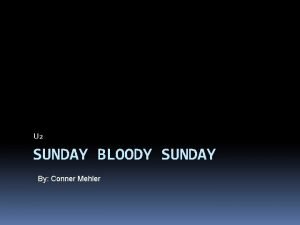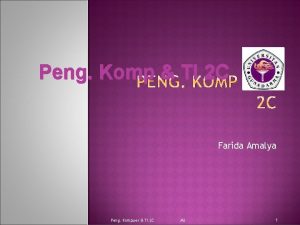Sunday Case of the Day Physics Qi Peng





- Slides: 5

Sunday Case of the Day Physics Qi Peng, Ph. D, Andres Rahal, MD, Ph. D Department of Radiology, UT Health Science Center at San Antonio, Texas History: 63 -year-old female underwent 3 -T MRI of the abdomen using a multichannel torso coil. One of the coronal images acquired with a single-shot TSE (or HASTE) sequence has a vessel-like artifact within the spine (red arrow). Challenge: Explain the artifact, and specify ways to avoid it. Coronal section of a single-shot FSE MRI.

Sunday Case of the Day: Physics Qi Peng, Ph. D, Andres Rahal, MD, Ph. D Department of Radiology, UT Health Science Center at San Antonio, Texas Answers: It is an aliasing artifact from a scan using a parallel imaging technique (eg, SENSE) wrapped into the FOV from the right side of the patient. The HASTE sequence used a parallel imaging technique (eg, SENSE) to decrease acquisition time; therefore the artifact is also at the center in addition to the left side of the patient. The prescribed FOV has to be increased to avoid this artifact.

Sunday Case of the Day: Physics Qi Peng, Ph. D, Andres Rahal, MD, Ph. D Department of Radiology, UT Health Science Center at San Antonio, Texas Findings 1. 2. 3. FOV coverage on the patient’s right side is not enough (red arrow). Imaging fold-over direction is left to right, as indicated by the aliasing artifact on the patient’s left shoulder (yellow arrow). There is an aliasing artifact on the patient’s left side (green arrow) folded from signal on the right side, although most of it is removed by the geometric correction algorithm of the 3 -T scanner.

Sunday Case of the Day: Physics Qi Peng, Ph. D, Andres Rahal, MD, Ph. D Department of Radiology, UT Health Science Center at San Antonio, Texas Discussion 1. 2. 3. 4. 5. 6. 7. Advanced imaging protocols are more widely used clinically on high-field magnets (eg, 1. 5 T and 3. 0 T) due to the inherent high SNR that can be used to speed up data acquisition using parallel imaging techniques, which lower SNR. To use parallel imaging, a multichannel coil has to be used. Multichannel coils also improve SNR, which also justifies the use of parallel imaging. Parallel imaging techniques generally undersample k-space profiles along the phase-encoding direction. A “reduction factor” of 2 means only half of the k-space phase profiles are acquired. The phase-encoding direction is also the direction that may suffer from aliasing artifacts if the prescribed FOV is smaller than needed. For 2 D coronal abdominal MR imaging, the phase-encoding direction is usually left to right due to its smaller dimension. Normally, aliasing happens at the edge on the other side of the image. This may not be true anymore if parallel imaging techniques are employed. For example, aliasing also happens close to the center of the image if the reduction factor is 2. It is always advisable to prescribe a large enough FOV to avoid aliasing artifacts overlapping the organ or pathology of interest or to use some other anti-aliasing techniques. This is particularly true when parallel imaging is used.

Sunday Case of the Day: Physics Qi Peng, Ph. D, Andres Rahal, MD, Ph. D Department of Radiology, UT Health Science Center at San Antonio, Texas Discussion 1. 2. 3. Another image obtained from the same patient with an even smaller FOV, also with a reduction factor of 2, generated more aliasing artifacts. The artifacts are worsened by the lack of field homogeneity on the edge of the main magnetic field, and aliasing results in superimposition of signals of different phases that alternatively add and cancel (moiré fringe pattern). Note that both the center and the edge of the image suffer from these artifacts.









